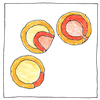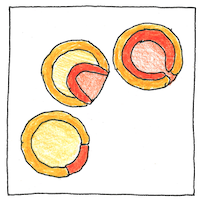Heinz Christian Pander
embryology

|
Germ layers
You can learn a lot from chicken eggs. For the early stages of embryonic development there’s no visible difference between a chicken and a human. After close study, I suppose, cracking a lot of eggs, Heinz Christian Pander, considered by many to be the founder of embryology, discovered that gastrulation produces three cell layers.
Gastrulation of the blastulation
The blastulation of the morula gives the blastula. The morula is like a mulberry of cells; the blastula has a liquid-filled center. The gastrulation of the blastula gives three layers— ectoderm, mesoderm, and endoderm. Gastrulation is followed by organogenesis, where separate organs begin to develop. The ectoderm begets— the epidermis, the neural crest, and the nervous system. The mesoderm begets— muscle and cartilage, ribs and the vertebrae, the dermis, the notochord, the blood and blood vessels, the bones and connective tissues. The endoderm begets— the epithelium, and the organs of the digestive system.
Embryogenesis
The ovum and the spermatozoon produce the zygote, which by cell division produces the morula, which is where our story started, though one must go back a half billion years to the first animals, which produces a lot of speculation. Many restarts but always without planning. Gradually, the path became convoluted, a mind inside a mind, a poem inside a poem, until the story begins again to tell itself.



The phrase “ontogeny recaptitulates phylogeny” expresses the idea that the development of embryos repeats the evolutionary stages of the species; however, evolution of a new creature is more interesting than the accumulation of changes to the end of its ancestor’s development. Eggs are single-cells but animal eggs are not the same as single-celled organisms; they contain only half the chromosomes of the mother.
See also in The book of science:
Readings in wikipedia: